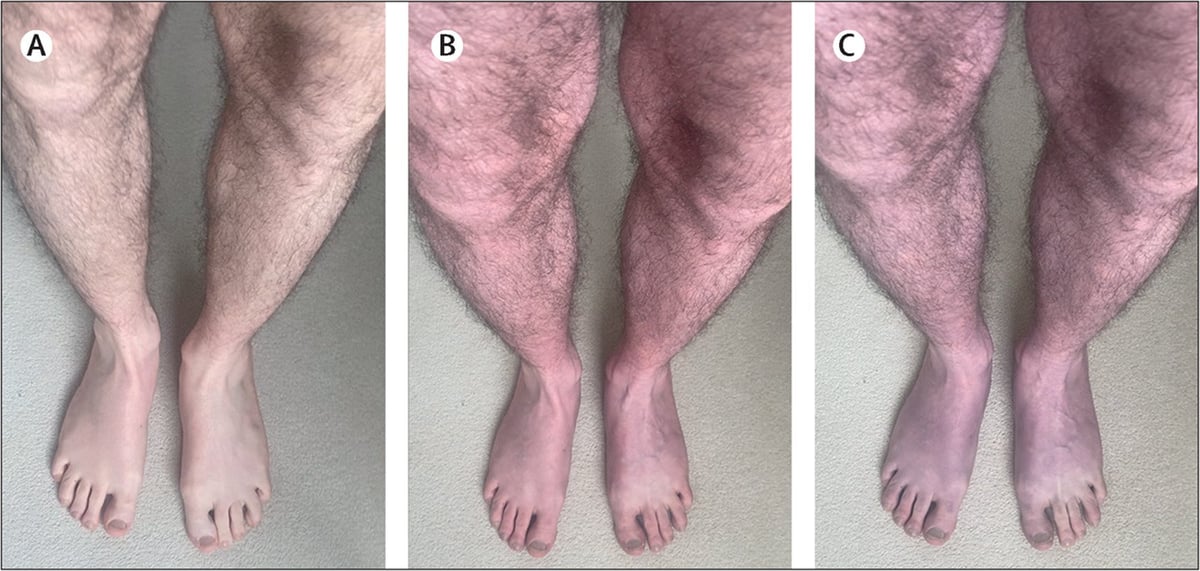Long COVID Triggered One Man’s ‘Blue Legs’ Syndrome

MONDAY, Aug. 14, 2023 (HealthDay News) -- A new scientific paper highlights a little-known symptom of long COVID: blue legs.
Called acrocyanosis, it happened to a 33-year-old man cared for by Dr. Manoj Sivan at the University of Leeds in the United Kingdom.
The patient stood and just one minute later, his legs began to redden, becoming increasingly more blue with his veins becoming prominent, Sivan and colleagues reported Aug. 12 in The Lancet.
After 10 minutes, the blue color was more pronounced. The patient felt a heavy, itchy sensation in his legs. Once he sat down, his normal color returned after about two minutes.
The symptom is acrocyanosis -- venous pooling of blood in the legs.
This man said he began having the discoloration after a COVID infection. He was then diagnosed with postural orthostatic tachycardia syndrome (POTS), which causes an abnormal increase in heart rate when an affected person stands up.
“This was a striking case of acrocyanosis in a patient who had not experienced it before his COVID-19 infection,” Sivan said in a university news release.
"Patients experiencing this may not be aware that it can be a symptom of long COVID and dysautonomia and may feel concerned about what they are seeing," he said, adding that clinicians may be unaware of the link between long COVID and acrocyanosis.
Long COVID can affect multiple body systems, including the autonomic nervous system, which regulates blood pressure and heart rate. Dysautonomia is the term for problems with this system.
“We need to ensure that there is more awareness of dysautonomia in long COVID so that clinicians have the tools they need to manage patients appropriately,” Sivan said.
People who have fibromyalgia and chronic fatigue syndrome can have dysautonomia. Doctors have seen acrocyanosis in children who have had a viral infection.
Previous research by Sivan’s team has shown that both dysautonomia and POTS often develop in people with long COVID.
“We need more awareness about dysautonomia in long term conditions; more effective assessment and management approaches, and further research into the syndrome," Sivan said. "This will enable both patients and clinicians to better manage these conditions.”
More information
The U.S. Centers for Disease Control and Prevention has more on long COVID.
SOURCE: University of Leeds, news release, Aug. 12, 2023
Related Posts
Estos consejos podrían facilitar la vacunación contra la COVID de los niños que temen a las agujas
VIERNES, 5 de noviembre de 2021 (HealthDay News) -- En todo el país, los niños...
Daily Insulin Dose Tied to Cancer Risk in Patients With T1DM
MONDAY, Aug. 1, 2022 (HealthDay News) -- Daily insulin dose is associated with...
Cardiac Arrest During Childbirth Is Rare, But Some Women Face Higher Risks
WEDNESDAY, March 15, 2023 (HealthDay News) -- It's extremely rare, but the...
Acupuncture Reduces Aromatase Inhibitor-Related Joint Pain
MONDAY, Nov. 14, 2022 (HealthDay News) -- Among women with early breast cancer...
